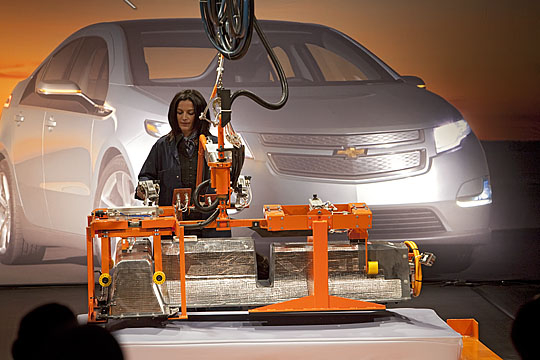The “reinvention” of the “New GM” began with the opening of a lithium-ion battery plant in Brownstown, Michigan, near Detroit. The event not only signals GM’s return to electric vehicles—for the first time in about 30 years, GM has opened a non-union plant in the U.S.
The new plant is funded in part by taxpayer dollars, and it is not rehiring any of the thousands of United Auto Workers members who were laid off when their plants closed—despite union promises that workers’ concessions on pay, benefits, and speed of work were their only chance for job security.
The plant, a wholly owned subsidiary of General Motors, opened January 7 and currently employs 25 hourly workers. Last year former CEO Fritz Henderson said GM planned to fill 100 hourly jobs at GM’s second-tier wages of about $14 an hour.
Now the Detroit Free Press reports that GM reached an understanding with the UAW last summer to pay less than $14, plus company-friendly classifications and work rules.
Henderson, meanwhile, who was fired by GM, is now being paid $60,000 a month as a “consultant” to work 20 hours a month—$3,000 an hour.
TRANSFORMATION
Speaking at the battery plant’s opening, GM Chairman Ed Whitacre spoke of the company’s opportunities in the transformation to green products. Apparently, GM’s transformation doesn’t include UAW representation.
Ed Niedermeyer points out in his blog thetruthaboutcars.com: “If GM can get away with using non-union workers at a crucial plant that’s supposed to represent the firm’s future, things aren’t looking so good for our friends in organized labor.”
What’s the response of the UAW? The silence from Solidarity House has been deafening. Sources at the International say an organizing drive is taking place at the Brownstown plant. But why couldn’t the UAW negotiate the right of laid-off UAW/GM members in the area to transfer there?
The same thing is happening at GM’s Powertrain plant in Baltimore, where new work coming in is considered a “stand-alone” operation and new workers are being hired at the cut-rate wage, while laid-off members wait for work. In Baltimore, however, the new workers will be part of the existing UAW local.
MORE NON-UNION WORK
A second indication of the UAW’s complicity in its own downfall is its agreement to allow GM to outsource work that isn’t directly related to the assembly of the vehicle. GM is not only outsourcing such “non-core” work but also trying to ensure that non-union workers perform it.
First, GM joined with Chrysler and Toyota to outsource Teamster car haulers’ work to non-union trucking firms. They have replaced the Teamster drivers at Ryder Truck with a non-union company.
Second, GM appears to be giving the green light to outside contractors to fight union organizing drives. In the past, suppliers were at least told they should be “union-friendly.”
When the UAW agreed to allow GM to outsource sanitation work several years ago, local unions (such as my local, Local 909 in Warren, Michigan) organized new in-plant sanitation workers and negotiated a contract for them—all with little or no interference from the new employer.
Now GM is changing its tune. The UAW allowed skilled trades jobs to be outsourced last year, and according to companies currently bidding on this work, GM has “no opinion” whether they should be union-friendly. This is a sure signal to contractors to fight organizing drives.
SOUTHERN STRATEGY
In the early 1970s the power of the UAW was at its zenith. The historic 68-day strike in 1970 and the 1973 negotiations with GM resulted in a 13 percent wage increase, improved health care, and retirement after 30 years of work.
In response, General Motors instituted its “Southern Strategy” in the mid-1970s. The idea was to duplicate GM’s operations in non-union Southern states, allowing GM to continue production if the UAW struck in the North.
Several organizing efforts failed at the Southern plants in the late 1970s and early 1980s. It was not until the UAW agreed to national contract concessions in early 1982 that GM agreed to card check in the South.
Concessions paved the way for union recognition at the Southern plants—but workers lost most of the major gains made in the 1970s and the union never recovered.
As GM now pursues a “Northern Strategy” to open high-tech, non-union green plants in the UAW’s backyard, where’s the union’s strategy?
No national leader has come forward with a plan to challenge the downward slide. There has been no Walter Reuther to demand a 12-point plan to re-industrialize the country through investment in closed plants to build mass transit, high speed and light rail, wind turbines, and all the things we need. There has been only silence.
A new leadership will be elected in June at the UAW Convention. There is nothing more for members to give. Will there be real debate about the way forward at the convention, or will the leadership continue to rearrange the deck chairs on the Titanic?
Al Benchich retired from GM’s Powertrain plant in Warren, Michigan, after 12 years as president of UAW Local 909 and is active in the Autoworker Caravan group.






